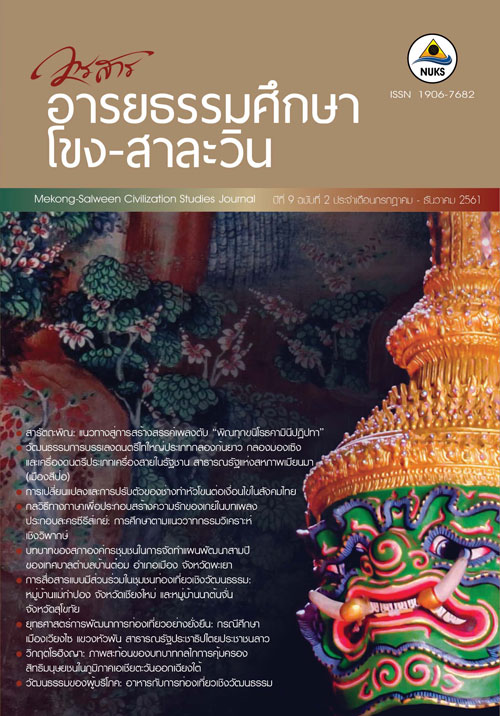The Essence of Phin: Conceptual Framework for the Thai Music Composition of “Phin-Dukkhanirodhagaminipatipada” สารัตถะพิณ: แนวทางสู่การสร้างสรรค์เพลงตับ "พิณทุกขนิโรธคามินีปฏิปทา"
Main Article Content
Abstract
This article is part of a doctoral thesis on the creation of the Thai music composition of “Phin-Dukkhanirodhagaminipatipada”, which aims to study phin music from the religious perspectives from various types of evidence, ranging from ancient documents in the Thai and Indian civilizations to the Tripitikata Buddhist scripture. The research findings are divided into three parts. First, it reveals two types of phin: 1) a lute falling into two different types: namely the long-necked plucked lutes, similar in shape to the krachappi, and the short-necked plucked lute such as a phin ha sai (a phin with 5 strings), 2) a resonated bow including the phin nam tao and the phin pia. Secondly, the findings with respect to organology from a study of Indian lutes (the bin and vina) reveal five different types of those instruments: (1) resonated bow, (2) bowed harp, (3) stick zither, (4) plucked lute, and (5) gatra vina (the word vina here refers to singing), while there are two types of phin instruments found in Thai culture: resonated bow and long-necked plucked lute with flat-backed sound box. Thirdly, a phin mentioned in the Tripitaka Buddhist scripture shows that: (1) in terms of meaning, a phin is conveys implications of Buddhist teachings. The strings and its sonority are used as metaphors for perseverance, industriousness, honesty, determination, sacrifice and obsession. A phin also implies the status of an individual, such as a person of great merits and charismatic authority, a person of great importance and custom of excellence; (2) In terms of its physical characteristics: harp, lute, and bow types of phin found, which correspond to the Post-Vedic musical instruments; and (3) In terms of roles and functions, a phin can be both melodic and drone instruments accompanying singing. These findings provide a conceptual framework for the creation of a Thai music composition, which the musical traits appearing in the Buddhist Tripitaka and in connection with the Indian music that existed at the onset of Buddhism are utilized.
Downloads
Article Details
References
Dharmaraja I Lithai, Phra Maha. (2012). A book in the “Traiphumikatha or Traiphum Phra Ruang” Thai Language series. Bangkok: SorKorSorKhor Press.
Komkhum, P., Pornprasit, K. (2015, January). Thai Classical Music Composition Pleng Ruang Puja Nakhon Nan. Journal of Urban Culture Research. 10(1): 52-63.
Kritsanaphong, T., Phoasavadi, P. (2017, July). The music of rice in Amphawa. International (Humanities, Social Sciences and Arts). 10(5): 492-505.
Kunst, J. (1949). The Culturl Blackground of Indonesian Music. New York: AMS press.
Mahachulalongkornrajavidyalaya. (1996). Thai Tripitaka, the Mahachulalongkornrajavidyalaya University version, Volume 4. Bangkok: Mahachulalongkornrajavidyalaya University Printing House.
_______. (1996). Thai Tripitaka, the Mahachulalongkornrajavidyalaya University version, Volume 5. Bangkok: Mahachulalongkornrajavidyalaya University Printing House.
_______. (1996). Thai Tripitaka, the Mahachulalongkornrajavidyalaya University version, Volume 10. Bangkok: Mahachulalongkornrajavidyalaya University Printing House.
_______. (1996). Thai Tripitaka, the Mahachulalongkornrajavidyalaya University version, Volume 18. Bangkok: Mahachulalongkornrajavidyalaya University Printing House.
_______. (1996). Thai Tripitaka, the Mahachulalongkornrajavidyalaya University version, Volume 22. Bangkok: Mahachulalongkornrajavidyalaya University Printing House.
_______. (1996). Thai Tripitaka, the Mahachulalongkornrajavidyalaya University version, Volume 26. Bangkok: Mahachulalongkornrajavidyalaya University Printing House.
_______. (1996). Thai Tripitaka, the Mahachulalongkornrajavidyalaya University version, Volume 27. Bangkok: Mahachulalongkornrajavidyalaya University Printing House.
_______. (1996). Thai Tripitaka, the Mahachulalongkornrajavidyalaya University version, Volume 28. Bangkok: Mahachulalongkornrajavidyalaya University Printing House.
_______. (1996). Thai Tripitaka, the Mahachulalongkornrajavidyalaya University version, Volume. 32. Bangkok: Mahachulalongkornrajavidyalaya University Printing House.
Mahamakut Buddhist University. (1980). Pali Tripitaka, the Syamaratthassa Tepitakam Version [Pali Tripitika of Siam], Volume 28. Bangkok: Mahamakut Buddhist University.
_______. (1980). Pali Tripitaka, the Syamaratthassa Tepitakam Version [Pali Tripitika of Siam], Volume 32. Bangkok: Mahamakut Buddhist University.
Midgley, R. (Ed.). (1976). Musical Instruments of the World: An Illustrated Encyclopedia. New York: Facts on File Publ.
Miner, A. (1998). (Musical Instruments: Northern Area) The Garland Encyclopedia of World Music: South Asia: The Indian Subcontinent (Volume 5). New York: Taylor & Francis.
Narisaranuwattiwong, Somdet Phra Chao Boromwong Ther Krom Phraya. (1970). Sarn Somdet Volume 5.
Bangkok: Kurusapha Lard Phrao Printing House.
_______. (1961). Sarn Somdet Volume 7. Bangkok: Kurusapha Lard Phrao Printing House.
Naksawat, U. (1987). Thritsadi Lae Kan Patibat Dontri Thai phak 1 [Thai Music Theories and Practices, Part 1: Principles and Theories of Thai Music]. Bangkok: Siriwit Co., Ltd.
Narom, K. (2005). Cambodian Music. Phnom Penh: JSRK.
Office of the Prime Minister. (1978). Prachum Silachareuk phak thee 1-4 [Corpus of Stone Inscriptions, Parts 1-4]. Bangkok: Office of the Prime Minister Printing House.
Pikulsri, C. (1997). Phin Nai Phra Trai Pidok [Phin in the Tripitaka], the book Buddhist Literature in Lanna. Bangkok: OS Printing House.
_______. (2001). Dontri India [Indian Music]. Khon Kaen: Khon Kaen University.
Poramanuchit Chinors, Somdet Krom Phra. (1965). Pathom Somphothikatha. Bangkok: Lieng Chieng Printing House.
Tramote, M., Kullatan, W. (1980). Fang Lae Khaochai Phleng Thai [Listening and Understanding Thai Songs]. Bangkok: Thaikhasem Printing House.
The National Library. (1986). Chareuk Nai Prathet Thai lem 3 [The Stone Inscriptions in Thailand Volume 3]. Bangkok: Pharbpim Printing House.
Wade, B. C. (2001). Music in India: The classical traditions. New Delhi: Print Perfect.
Wiwatthanapathapi, T. (1995). The Isan Folk Mahori of Pathumrat District, Roi-et Province. Bachelor Thesis, Art program, Mahasarakham University, Mahasarakham.
Wrazen, L. (1986, Autumn - Winter). The Early History of the Vina and Bin in South and Southeast Asia. Asian Music. 18 (1): 35-55.
Yupho, D. (1980). Khruang Dontri Thai Phrom Duay Tamnan Kan Phasom Wong Mahori Piphat Lae Khruangsai [Thai Musical Instruments and Legends of the Combining of Mohori, Peephat and Khrueng Sai Ensembles]. Bangkok: Fine Art Department.

